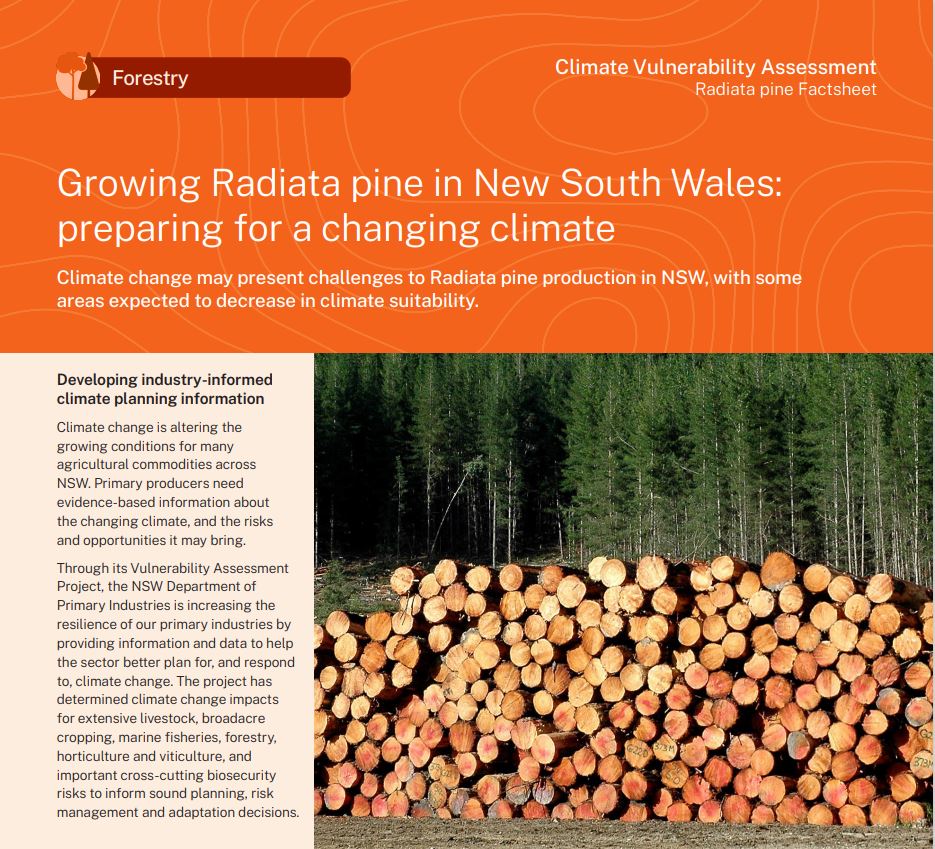Climate Vulnerability Assessments
For softwood plantation forestry, the selected timber species was Radiata pine (Pinus radiata). Visit the Radiata pine page for more information about this commodity and to view its factsheet and results report.
Results
The Climate Vulnerability Assessment modelled the historical and future climate suitability for each commodity across NSW. These assessments considered the change in suitability between the historical (1981-2010) and future time periods (2036-2065), reported separately for the two emissions scenarios.
Maps of historical and future climate suitability for Radiata pine were produced to demonstrate where in the state a commodity is likely to thrive or else be limited by future climatic conditions. The maps are provided in the Radiata pine results report and the factsheet below lists the important impacts and provides interpretation of the drivers of changing climate suitability.
Care should be taken when interpreting these results. The Climate Vulnerability Assessment is intended to highlight potential changes in future climate suitability at industry and regional levels. It should not be interpreted at the scale of individual holdings.
Factsheets
Radiata pine factsheet
PDF, 429.85 KB

Approach
The Climate Vulnerability Assessment required a modelling approach that could be rapidly and consistently applied to different commodities and biosecurity risks to produce consistent and comparable models. To this end, a framework was developed which combined research literature, expert industry knowledge and climate data in a modelling approach known as ‘multi-criteria analysis’ (MCA model). The resulting MCA models were used to evaluate the suitability of NSW’s climate for chosen commodities and biosecurity risks.
The general assumptions for the forestry MCA model were:
- a specific species is described (Pinus radiata),
- best current silvicultural practice was deployed at site-level management (e.g., thinning timing, mounding),
- all life stages of Radiata pine are present within any 0.05-degree pixel (5km2),
- the trees are free of pests and diseases, and
- short term heat-waves, bushfire and the impact of prolonged drought are not explicitly modelled.
For more information on the methodology and data used in the climate vulnerability assessments, please refer to either the methodology summary page or, for an in-depth explanation, the Climate Vulnerability Assessment Methodology Report.
References
NSW DPI (2023) Performance, data and insights 2022 forestry summary, NSW Department of Primary Industries, accessed 11 October 2023.
Schirmer, J., D. Gibbs, M. Mylek, A. Magnusson and J. Morison, 2017. Socio-economic impacts of the softwood plantation industry in the South West Slopes and Bombala region, NSW.
Australian Bureau of Agricultural and Resource Economics and Sciences (ABARES) (2021). Australian Forest and Wood Product Statistics September and December quarters 2021.
Jobs. Industry. Communities. Timber (2015) Timber NSW brochure, accessed 11 October 2023.
Australian Bureau of Agricultural and Resource Economics and Sciences (ABARES) (2023). Australian plantation statistics 2023 update data tables, accessed 11 October 2023.